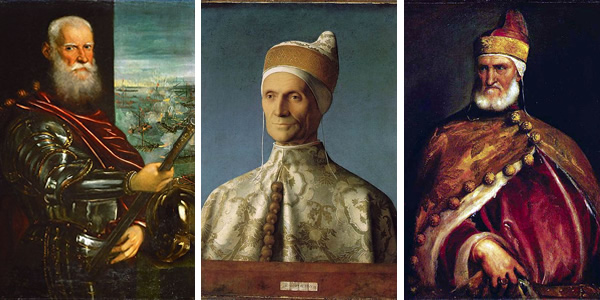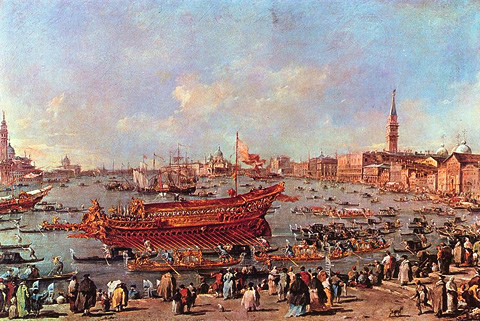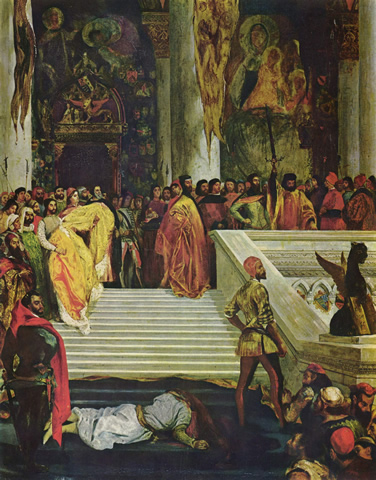- Places
- Plans
- Itineraries
- Experiences

The Palazzo Ducale is Venice's ducal palace, and in old Venetian dialect, the duke was called the doge or doxe, after the Latin dux, a military leader (which is what European dukes originally were; the title of "duke" was the feudal equivalent to "army general").
In Venice, however, the doge was neither a military man nor an autocratic ruler. The doge was the head of state, but acted in essence as the highest-level servant of the Republic.

By tradition, the first doge was Paolo Lucio Anafesto, elected in 697. However, the first one we can pin down historically as a true dux of Venice was the "third" doge, Orso Ipato, elected in 726.
One nice thing about accepting the 697 date is that is offers nice symmetry: Napoleon deposed the last doge (Ludovico Manin) in 1797.
The doge's power and responsibilities varied throughout the ages, though he was the only one who could attend meetings of any government organization, and the only man allowed to read all the republic's secret files.
Eventually he served mainly as a sort of presidential figure, the official head of state and a fulcrum balancing the other powers of the various interlocking ruling circles of senates, councils, ages, colleges, inquisitors, and judges, all of which were made up from the city's nobility and commercial elite.
A doge was elevated from among the aristocracy, was almost always of an extremely advanced age—the average age for an incoming doge was 72. They served for life, see, and no one wanted any one doge to have power for too long.
Each new doge was chosen through an impossibly Byzantine (no pun intended) process filed with so much chance and rounds of elimination as to be thoroughly fair and random.
Here is how Mary McCarthy explained it in Venice Observed:
"Out of the Great Council (consisting at first of 480, then of 600, and finally of 1,200 nobles), 9 were picked by lot to elect 40 electors, who had to be chosen by a majority of at least 7.
The 40 drew lots to see which 12 would elect 25 more by a majority of at least 7.
These 25 then drew lots to see which 9 would elect 45 by a majority of at least 7.
Finally, these 45 drew lots to choose 11, who would vote for 41 electors, who would elect the doge by a majority of at least 25."
As if that weren't enough, at several stages—to add impartial chance into the mix—these lots were drawn from a hat by a child plucked off the street by the council's youngest member (who, presumably, would have fewer entrenched loyalties to any particular cadre in the council).
For all this, a doge was paid a ridiculously enormous salary—mainly so that no outside force could afford to bribe him.
The system worked surprisingly well. After some rough going in those first few centuries of the system—when it seems half the doges were either exiled, assassinated, or resigned to become monks—from the late 11th century through to the end only two doges were forced from office.
The last time a doge was forced from office, in 1457, was a sad case. Doge Francesco Foscari spent most of the 34 years of his dogeship fighting a protracted war with Milan.
However, when he was 84 his only surviving son, Jacopo, was convicted of bribery and corruption, exiled from Venice, and eventually jailed on Crete where he died.
The grief-stricken doge retreated from his duties and was forced by the Council of Ten to abdicate. He died one week later.
The only other time (after 1084) that a doge was removed from office involved the only ducal traitor in the thousand-year history of Venice.

He and his conspirators quickly failed and were executed—but he also received a novel punishment.
Marin Falier was condemned to damnatio memoriae, the eradication of his name and memory.
The only official record of him remains the painted black shroud where his portrait would otherwise be among the pantheon of doges ringing the Great Council Chamber of the Palazzo Ducale.
Beneath it reads the Latin inscription, "Here is the place for Marini Faletro, beheaded for his crimes."
Share this page
Search ReidsItaly.com